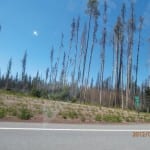The Real Reason the Power Went Out and Stays Out
 By Gail Zawacki. Republished with author permission from Reader Supported News.
By Gail Zawacki. Republished with author permission from Reader Supported News.
SUGGESTED BY OUR COLLEAGUE ROWAN WOLF } REPOSTED FROM CYRANO’S JOURNAL TODAY
Photo by Rowan Wolf of tree death due to beetle blight in the region of Crater Lake, Oregon.
I live in New Jersey where it looks like the ecopocalypse has arrived.
It seems obvious that the sea-level rise and the size of the storm are related to the energy humans are adding to the system by burning fuel and releasing millions of tons of greenhouse (heat-trapping) gases into the atmosphere. That’s high school science and as obvious as plate tectonics. Remember when that was a controversy? Or that seat belts in cars, or helmets for bikes save lives? Asking if climate change has something to do with Sandy is like asking if smoking has something to do with lung cancer. Remember when people could say with a straight face that it didn’t?
Having said that, there is a very large story that isn’t being reported which has little to do with climate change although it derives from the same processes.
What is being ignored in this storm (and Irene as well) is the real source of the massive power outages that are so disruptive – which is all the trees that are falling on the lines. Trees didn’t used to fall with regularity on power lines – or people, cars and houses. The winds in both those storms were not extraordinary, nothing that a healthy tree shouldn’t be able to withstand.
Why are they falling now? The answer is pretty obvious if you trouble to actually LOOK at them. They are all dying. Every species, every age, every location. They have obvious symptoms – broken branches, cankers, splitting bark, holes, thin crowns, early leaf drop, lack of autumn color, yellowing needles, bark covered with lichens and fungus. You can’t find a healthy tree anymore.
So the question becomes, why are they dying? Most foresters and scientists will say, climate change and/or invasive pests. But those explanations don’t fit the empirical evidence which is that even native pests and diseases have run amuck, and even young trees grown and watered and fertilized in nurseries exhibit the identical symptoms of decline. Even annual, tropical ornamentals in enriched soil in pots that like heat, and aquatic plants in ponds have injured foliage and stunted growth.
What do all of these plants have in common? The answer is, the composition of the atmosphere. Most people don’t realize it, because it’s invisible, but the background level of tropospheric ozone is inexorably increasing. Precursors from Asia travel across oceans and continents, and the persistent concentration has reached a threshold that is intolerable to the plants that absorb it when they photosynthesize. Agricultural yield and quality are reduced, and especially trees that are exposed to cumulative damage season after season are universally – around the world – in decline.
This process has been well known to foresters and agronomists for decades, and demonstrated in field observations and controlled fumigation experiments. They just don’t want to publicize it, or even admit it, because the source is the emissions from industrial civilization itself. They would rather point to drought, insects, fungus and disease EVEN THOUGH it is well known that ozone debilitates plants causing their root systems to shrink as they allocate more energy to repairing damaged foliage, rendering them more vulnerable to drought and wind…AND impinges on their natural immunity to attacks from insects, disease and fungus, which exist precisely to break down dying trees, not destroy healthy trees.
Most of the trees that fell during Sandy were rotted inside. Photos here: http://witsendnj.blogspot.com – At Wits End
______________
Gail Zawacki has an excellent photo documentation with her discussion in this post – This Imposter at her blog At Wits End.
//